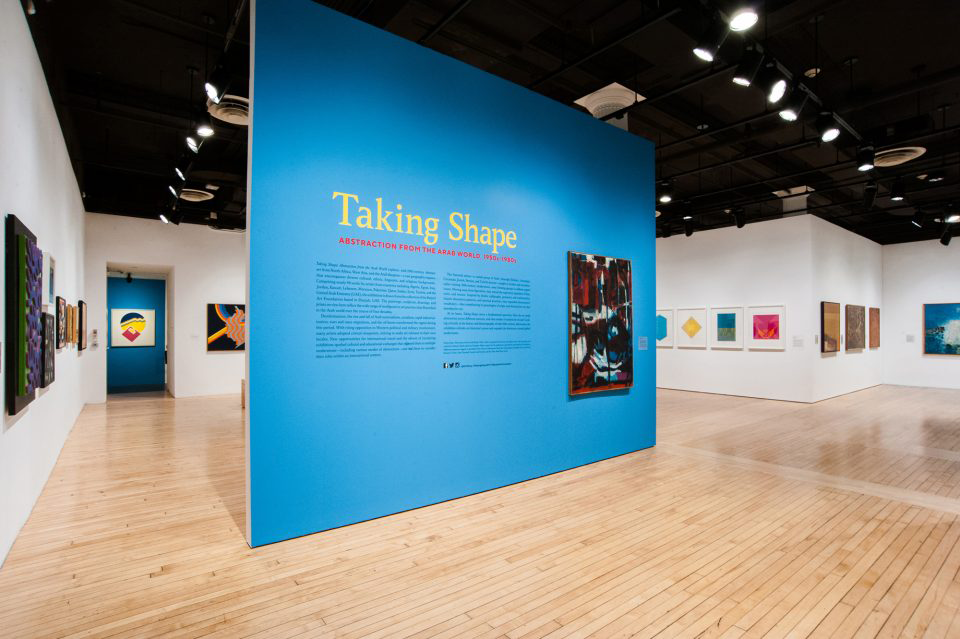Over the past decade, identity has dominated both political and cultural discourse in the US. With the new decade at a nascent stage, a former Georgetown instructor looks to use visual art to expand the scope of the identitarian dialogue, starting at New York University’s Grey Art Gallery with “Taking Shape: Abstraction from the Arab World, 1950s-1980s.” With its diverse array of pioneers on display, and the various schools of abstract art it promotes, the exhibition is an excellent window into the world of Arab art for connoisseurs and diletantes alike.
Sultan Sooud Al Qassemi, the founder of the United Arab Emirate’s Barjeel Art Foundation, along with curator Suheyla Takesh, are bringing the foundation’s collection of modern and contemporary Arab art to the US for the first time. The touring exhibition represents a significant step in allowing art from the non-Western world to be presented on its own terms. That artistic ownership is significant given the controversies of how Western museums acquire and keep art from other parts of the world.

The title itself eliminates the conventional yet ambiguous regional marker of “Middle Eastern” and narrows the categorization from a geo-ethnic term to a linguistic one. This framing allows the exhibition to focus on abstract art movements native exclusively to the Arabic-speaking world and the pioneers that spearheaded them. Consequently, the exhibition avoids the risk of grouping together Arabs with Persians and Turks in a way that previous Orientalist displays of art have in the past.
The Hurufiyya movement works are no better demonstration of the exhibit’s emic nature. Deriving from the Arabic word for “letters,” the movement is marked by artists playfully exploring the intersection of calligraphy and abstraction to create an Islamic-inspired visual language. Since the movement’s inception in the early 20th century, there has been an abundance of interpretations for how to artistically manipulate Arabic typography.
The exhibit features the more literal expressions of letters of Rachid Koraïchi, whose works almost read like artistic manuscripts, but there are also the more enterprising and interpretive pieces of Sudanese innovator, Ibrahim El-Salahi. His works, like “The Last Sound,” create abstract landscapes that open viewers up to a kaleidoscopic world of interpretations. For example, the multilinear circle could be interpreted as a clock, a series of musical notes, or even a halo around the central figure. Works like these make the exhibition a positively active and engaging experience for viewers. Hamed Abdalla’s “Al Tamazouq (Torn)” offers an ominous vision of what calligraphy could be, as the painting intentionally appears to rupture across the canvas.
While much of the exhibit’s Hurufiyya works were marked by sepia tones, works from Casablancan painters offered both a pleasant and starkly polychromatic contrast. Artists like Mohamad Chebaa and Mohamad Melehi inventively experiment with primary colors, resulting in paintings as bold as their palettes. This section of the exhibit tests both the rules of symmetry and color complementarity, introducing viewers to an abstraction that transcends the simplicity of monotonous works produced in other parts of the world. Even artists outside of the Moroccan port city use simple paints resourcefully, some in provocative ways. From Huguette Caland’s bright red depiction of a rear end, to Mohammed Hamidi’s bubblegum-style genitalia, the Barjeel Foundation has not shied away from revealing to the world the more daring Arab artists of the 20th century.
Selections like these combat narratives of a hyperconservative region that suppresses art in all its forms, and the effort made by Takesh and Al Qassemi is more than commendable. The representational battlefield is refreshingly extended to the realm of gender, with the exhibition including works from the most significant women in Arab art history. Be it Samia Halaby, who was in attendance on the day of the opening, or the dynamic Lebanese duo of Saloua Raouda Choucair and Etel Adnan, Taking Shape exhibits the work of women that birthed visual movements and inspired generations of artists after them.
The beauty of the exhibition’s opening was that many of these trailblazers were present and taking pictures with their works. Following a speech by Al Qassemi, who taught at Georgetown in the Fall of 2019, the crowd wandered and admired the many masterpieces on display while asking Halaby and co. about the inspirations that drove these pieces’ production.
Besides the two levels of art, there was a welcome performance by the Syrian-American Jewish singer, Faraj Abyad. Accompanied by his mostly-stringed orchestra, Abyad provided attendees with a medley of songs from across the Arab world. Despite the regional variances in musical styles, playing songs from Egypt, Syria and even the Gulf, the crowd immersed themselves gleefully and celebrated the occasion and culture being honored. It marked a spectacular way to commemorate the remarkable art that emerged in a crucial four-decade span of Arab history.
Taking Shape runs in NYU’s Grey Art Gallery from Jan. 14 to April 4, 2020.



















